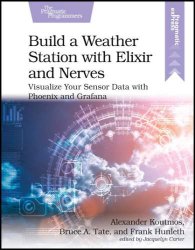 Название: Build a Weather Station with Elixir and Nerves: Visualize Your Sensor Data with Phoenix and Grafana
Название: Build a Weather Station with Elixir and Nerves: Visualize Your Sensor Data with Phoenix and GrafanaАвтор: Alexander Koutmos, Bruce A. Tate, Frank Hunleth
Издательство: The Pragmatic Programmers
Год: January 2022 (Version: P1.0)
Язык: английский
Формат: pdf (true), epub (true)
Размер: 13,5 MB
The Elixir programming language has become a go-to tool for creating reliable, fault-tolerant, and robust server-side applications. Thanks to Nerves, those same exact benefits can be realized in embedded applications. This book will teach you how to structure, build, and deploy production grade Nerves applications to network-enabled devices. The weather station sensor hub project that you will be embarking upon will show you how to create a full stack IoT solution in record time. You will build everything from the embedded Nerves device to the Phoenix backend and even the Grafana time-series data visualizations.
Elixir as a programming language has found its way into many different software domains, largely in part to the rock-solid foundation of the Erlang virtual machine. Thanks to the Nerves framework, Elixir has also found success in the world of embedded systems and IoT. Having access to all of the Elixir and OTP constructs such as concurrency, supervision, and immutability makes for a powerful IoT recipe. Find out how to create fault-tolerant, reliable, and robust embedded applications using the Nerves framework.
Build and deploy a production-grade weather station sensor hub using Elixir and Nerves, all while leveraging the best practices established by the Nerves community for structuring and organizing Nerves applications. Capture all of your weather station sensor data using Phoenix and Ecto in a lightweight server-side application. Efficiently store and retrieve the time-series weather data collected by your device using TimescaleDB (the Postgres extension for time-series data). Finally, complete the full stack IoT solution by using Grafana to visualize all of your time-series weather station data. Discover how to create software solutions where the underlying technologies and techniques are applicable to all layers of the project.
The Erlang virtual machine and the Elixir programming language have managed to find their way into a wide range of software domains. We believe that this is very much in part due to the technical merits of the BEAM runtime and the phenomenal developer experience that the Elixir programming language provides. With both of these elements at your disposal, you truly feel like you have superpowers when programming with Elixir.
This feeling of having “superpowers” is immediately apparent if you’ve ever written, maintained, or deployed a Phoenix application. The fault tolerance, scalability, and ease of development that you get from the Phoenix Framework and Elixir is a thing of beauty. Not to mention that if your requirements include some sort of real-time user interaction, the tooling available to you in the Elixir ecosystem is second to none.
While Elixir has enjoyed great success in the API back end and web-application space (thanks to Phoenix LiveView), what if you could realize these same “superpowers” in an embedded systems and IoT context? That is exactly what the Nerves Project aims to do. With Nerves, you can develop reliable and fault-tolerant IoT applications without compromising productivity. Nerves takes care of all of the lower-level concerns, leaving you with only the application-specific concerns. In addition, since you have the power of the Erlang virtual machine at your fingertips, you can create concurrent real-time applications leveraging all of the abstractions that you already use.
Take your project from idea to production ready in record time with Elixir and Nerves.
What You Need:
To complete the Nerves weather station project in this book, you will need the following:
A Linux, MacOS, or Windows computer to build and deploy Nerves firmware images
A Raspberry Pi Zero W or any other Nerves supported target
A VEML6030 light sensor
An BME680 environmental sensor
An SGP30 air quality sensor
Qwiic connect cables for weather sensors
Скачать Build a Weather Station with Elixir and Nerves: Visualize Your Sensor Data with Phoenix and Grafana